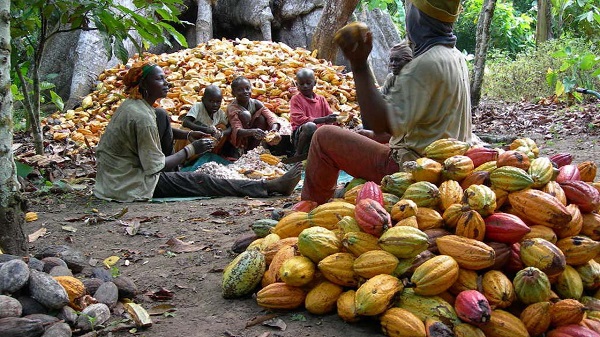
People born between the ’60s and ’80s would definitely know the value of cocoa production in Nigeria. Cocoa is a crop Nigeria once banked on as its major exported cash crops before the oil boom. Nigeria was the biggest exporter of cocoa in Africa and one of the biggest in the world. Then Crude Oil came and poor agricultural management set in, costing the Nigerian economy badly and allowing Nigerian to lose the prestigious spot to a fellow African country, Cote d’Ivoire, who is now the largest cocoa producer in the world, followed by Indonesia.
When cocoa production and export are concerned, Nigeria only lives in past glory and if care is not taken, Nigeria might end up losing all it has gained from the export of what is touted as some farmers as the ‘Wealth Seed.’ The demand for Cocoa now is significantly higher than what the demand was, back then. When the agricultural spotlight is focused on Nigeria, foreign countries can vividly see the potentials in Nigeria and would quickly act fast in taking advantage of it, while Nigerians sit on a goldmine and yet they can’t see it but only look forward to foreign aid and investments.
Anyone looking to delve into Cocoa production business in Nigeria is in for a bit of a fortune if he really knows his onions. For a long time, Cocoa has been and would for a really long time still be one of the fastest-selling agricultural products in both the international market and the local market. As stated earlier, there is a high prospect for cocoa business to thrive in the country. This is because it is in high demand all over the world as it is used in the manufacture of different things such as candy bars, chocolate, cocoa powder as well as drinks and several others. Cocoa farming and beans extraction are labour intensive and the beans are fragile. This pushes many people from the business, especially in a country like Nigeria where there are deficiencies of preservative facilities.
Although Cocoa is not the easiest of crops to manage, once a potential merchant can sacrifice the time and the effort to have it planted, groomed and nurtured to its full maturity, he can keep getting attractive returns on it for a time as long as decades. Truth be told, cocoa production in Nigeria is one very under-exploited and under-utilised sector and Nigeria still needs as many farmers in the cocoa production section as possible, since demand continues to outweigh supply. There are still thousands of acres of fertile lands that can still be used for the planting and cultivation of cocoa. Just like any other business, a potential Cocoa merchant must have a well-designed business plan that will guide the cocoa business. This means that he must first sit down and work out things involved in the cocoa business and have a road map on how to go about it.
Delving into Cocoa Farming and Production
Starting the cocoa farming and production business in Nigeria isn’t as hard as it seems, especially if one can endeavour to gather the right information and knowledge about the business. Armed with the right knowledge on cocoa farming, botany, industrial value and demand chain, a potential cocoa merchant can be able to utilise and exploit the huge profits associated with the business, and with time he might soon become a big player in the cocoa production business.
It is also worthy to note that the returns on cocoa business start small but grows on bigger and bigger with time and the right amount of effort.
The first major step in delving into Cocoa Farming and production is Financial Planning
Anyone who has an interests in cocoa cultivation must first work out the different costs. Different costs are involved and fundraising for the business is also important. Furthermore, research has shown that cocoa can grow together with other cash crops like Coconut and Cashew so combining the production strategies is a good way to maximise profits.
Capital also plays a large role in the kick-off of this business. A potential merchant has to decide if he would be going into Cocoa cultivation large scale or small scale. This decision would influence the amount of capital he would be investing in the business. This is why a good Business plan goes a long way in determining the success rate of the cocoa cultivation business.
Other things needed are:
- Piece of Land: If the merchant wants to see through his business from start to finish, he would unavoidably need an area of land to start his cocoa business, but it all depends on what he can afford. For a small scale business, he doesn’t necessarily have to get farmland, as he can simply buy fresh cocoa seeds from farmers who’ll sell it at a much lesser price.
- Storage and Drying Space: The merchant would inevitably need to have a store or warehouse, secure enough to give his business (the cocoa seeds) the required safekeeping it needs. His business is his cocoa seeds, as he has no business with the pods. Also, the store needs to have enough space outdoors for him to spread his seeds. Cocoa seeds need to be dried in the sun for it to be usable. The drying period normally takes a period of two weeks.
- Relevant Equipment: The merchant would need equipment like the scale for weighing the bags, normal sacks and heavy-duty sacks, for conveying the seeds from one place to another, and a wide water-proof material that can be used in drying the seeds in open air.
- Cocoa Seeds: There goes the tiny but most integral part of the business. The cocoa seeds can either be bought from cocoa farmers or harvested if the merchant already has access to a cocoa farm, an option which is advisable later in his business when you have the money.
Land Preparation
Cocoa is a crop that cannot do well in all kinds of soil. This means that before a potential merchant commences the business, he must test the soil to determine the type of yield he would be able to attain during harvest season.
Crop protection and nutrient management are also important in this kind of business. Cocoa is known to grow well in some parts of Nigeria, especially the western part of Nigeria. One can consider acquiring land in any of these places to grow cocoa.
The Type of Cocoa Variety to Invest in
Another aspect a prospective merchant will pay attention to is the best variety to plant. This is that the reason soil test will help him discover the types of cocoa species that are compatible with a particular soil or environment.
There are at least three varieties on the market and they include the Trinitario, Forastero, as well as the Criollo. Apart from that, there are also some improved varieties, which can be gotten from other parts of the world, and these can do well in Nigeria.
Planting Process
Method of Propagation
When it comes to Cocoa cultivation, there are two options available to the merchant, which include the Vegetative and Seed propagation. A lot of people prefer Seed propagation because it seems to grow faster than the Vegetative propagation. Germinations starts within a week of propagation and moreover, a greater percentage of it can germinate (at least ninety per cent or more of the seed). The survival rate is higher in seed than in vegetative propagation.
Also, this stage is where the main business starts. A Cocoa merchant can also engage in mass production of cocoa after the seeds have germinated, he can transplant them using a perforated polythene bag. He can also sell some of the seedlings. Other merchants who deal in Cocoa seedlings will like to buy it.
On the other hand, many large-scale producers prefer the Vegetative option than the seedling option. Vegetation is grown through such methods like grafting, root cuttings, as well as stem budding and so on. In Nigeria, many cocoa farmers prefer the budding option.
Planting
When it comes to planting, the merchant has to be careful the way he plants it to ensure that it survives. If after testing the soil and he discovers that it is not that fertile, there are still other alternatives. He would have to dig a pit of about 50 by 50 by 50 centimetres. This advice is very important if he resides in the lateritic zones where the soil is known to be low fertile.
After digging the holes, he must make a soil combination of organic manure and topsoil and fill the pit with it. This is to enhance the survival rate. Those in fertile areas have nothing to worry about.
It is always recommended to plant it on a soil surface. The cocoa root grows well in surfaces irrespective of the depth.
After-cultivation Care
There are a few must-dos that attract a bumper cocoa harvest, time and resources are of the essence when taking care of the cocoa. Once the planting is finished, the next thing to do is to mulch the basins using organic manure.
Shoots emerging from the lower portions must be removed. This is to ensure healthy development and growth of the shoot. The planting can last three to four years, but the process always has to be weed-free.
Fertilisation and Manure
The essence of the soil test is to determine soil fertility. This can equally assist in determining the right type of manure to apply. In Nigeria, NPK fertilizers are popular and this can be applied in two equal splits.
The dose to apply depends on the yield wanted. For species that yield up to sixty pods yearly, the dose must be doubled.
In addition to that, the merchant can administer dolomite to each plant yearly. This can start from the third year of the cocoa plantation. The best method to administer fertilizer to the cocoa crops is to mix fertilizer with soil in a basin and administer it to the plant.
Pruning
The cocoa plant requires pruning and it grows in tiers. If properly managed, the plant can produce five fan branches. It is better if the growth is restricted just to one-tier. Because of that, there is the need for constant pruning.
Irrigation
Irrigation is necessary if there is no adequate rainfall distribution. Naturally, it grows well under well water. Supplemental irrigation is a necessity if the merchant stay in areas where there is no adequate water supply. Water is necessary because it helps cocoa plants to grow very well and makes the yield better.
Protection
Cocoa like other cash crops needs to be protected from diseases, pests, and vagaries of nature. The most important thing is to protect them from those harmful insects and pests around. There must be an adequate arrangement for chemical spraying and other ways of protecting it.
Harvesting
This is the time to yield the benefits of labour. It takes about one hundred and seventy days for the cocoa to be ready for harvesting. After harvesting the pods, the merchant can store it for four days. This facilitates fermentation. Furthermore, it makes superior quality cocoa beans possible. The pods should not be overripe before harvesting.
There are two harvesting seasons in a year; light and heavy harvest.
After harvesting, it is time for fermentation. With a good cocoa processing unit, the merchant is sure of producing different varieties of cocoa beans.
Marketing and Export
The target markets are food and beverage companies, soap making industries, chocolate producing companies etc. A ton of cocoa seeds is sold between $2195 – $3130 in the International market. Locally cocoa has a standard price of 50kg selling for ₦55,000.
There are a variety of ways that cocoa is exported from Nigeria. In some cases, one or even two middlemen are involved between the Nigerian farmers and cocoa exporters. The Nigerian trade begins with farmers working to harvest cocoa beans from the local crop. The following are ways in which cocoa beans are exported from Nigeria:
- Farmers to Small Buyers – Small buyers visit individual clients (farms) to purchase a share of the cocoa crop. In this method, small buyers may sell the crop directly to exporters, but more commonly the small buyers sell the cocoa to wholesale buyers who make the final sell to exporters.
- Farmers to Co-operatives – Farmer co-ops combine cocoa from several farms to sell to different agencies. The co-op purchases cocoa directly from farmers, and in some cases, sells it to exporters directly. In other cases, the co-op may also export the product directly.
Nearly half of all Cocoa in Nigeria is exported to the Netherlands (45%). Germany and Malaysia are ranked second and third in cocoa imports from Nigeria, importing 22% and 6.2% of Nigeria’s cocoa output, respectively. Other top importers of Nigerian cocoa include Spain, Italy, Belgium-Luxembourg, and China.
Nigerian cocoa and cocoa beans are usually exported in the raw or unprocessed form to chocolate processing plants in these countries. The cocoa is typically exported to confectionary companies to make chocolate bars and other chocolate products, such as candy, cakes, and chocolate beverages.
List of Cocoa Exporters in Nigeria
The International Cocoa Organization (ICCO) based in Ivory Coast maintains a directory of farmers, exporters, and other professionals related to the cocoa industry. Although Nigeria was a member in 2010, the country is not listed among the organisation’s members in 2018.
Cocoa Exporters in Nigeria
The list of cocoa exporters in Nigeria include:
- FTN Cocoa Processors Plc
- Ideal Risku Global Limited
- Saro Agro-Allied
- Tosmega Cocoa Nigeria Limited
- Akeen and Kamoru Nigeria Ltd
- Berveek Limited
- Cocoa Products (Ile Oluji) Ltd
- Remedy Crown Investment
- Shinwillcrown Cocoa Producing Company
The list of cocoa bean exporters of bulk and wholesale cocoa beans from Nigeria include:
- Agro traders Ltd
- Crystal Green Ltd
- Gbemtan Investment Ltd
- Olatunde International Ltd
- Agebelere Cocoa Farm
- Okon & Sons Integrated Services Ltd
- Ose Global Bizness Links Nig. Ltd.
- Terry Cocoa Merchant
- Yinka Akintilo Enterprises Ltd
Cocoa Production in Nigeria: Feasibility Study
The feasibility study included in this guide is for a medium cocoa production business, from the start to the sale of 500 bags of cocoa. The Capital covers from store set-up, land acquisition, seed purchase, production, and marketing.
The selling price of cocoa is the same almost everywhere. Each bag (A standard of 50 Kg) is being sold for about ₦55,000.
For a start, all the materials needed (Renting a store depends on location, purchase of needed equipment, planting and tendering, and so on, is approximately ₦3,500,000)
If the merchant starts harvesting after 18 months, (he can start harvesting as soon as that if he had planted the early-maturing, high-yielding and disease-resistant cocoa beans seed to boost his farm’s production in a short period of time).
₦55,000 X 500 = ₦27,500,000
(Return on Investment) ROI = ₦27,500,000 – ₦3,500,000 After 18 months of cultivation, the gain is a staggering ₦24,000,000; which isn’t bad at all especially since selling cocoa beans seed doesn’t take much marketing.
Issues Affecting Cocoa Export in Nigeria
Before you engage in the cocoa trade in Nigeria, it’s important to consider how to overcome common challenges affecting the cocoa trade and cocoa exporters in Africa. These concerns include everything from adequate production to transportation. Educating yourself on these issues may not eliminate the concern, but can help you determine a plan of action before engaging in trade.
- Roads and Transport – More than 30,000 tons of cocoa were found delayed in transit in the capital city of Lagos while en route to ports for export. Specifically, traffic, craters, and floods are to blame for the delay. This delay put strain on local businesses and some even sought loans to cover expenses while waiting for exports to be shipped and paid by buyers.
- Delays in cocoa production – For many years, Nigeria ranked fourth behind Ivory Coast, Ghana, and Indonesia in cocoa production, but a recent drop in production has lowered Nigeria’s position in the cocoa production chain to fifth, tied with Cameroon. Lack of support for farmers, including access to cocoa seedlings, price risk management, and pest control training are just a few factors that have led to a decrease in cocoa production. Many small farms harvest most cocoa in Nigeria throughout the southern region.
- Lack of farmers – Several news reports outline both the lack of younger farmers and the lack of interest of younger farmers in cocoa farming. This lack of interest has led to a decrease in the number of cocoa farmers. While there have been calls to stimulate the cocoa economy, the Nigerian cocoa production efforts faces significant challenges to its growth if enough young farmers don’t participate in the cocoa trade.
COCOA PRODUCTION: RISKS INVOLVED
- Managing a cocoa farm takes time, effort, patience and energy.
- Constant guard and protective measure against rodents and infectious parasites.
- Setting up a cocoa production plant is very capital intensive.
COCOA PRODUCTION: ADVANTAGES
- Cocoa sells faster than almost every other agricultural produce.
- The merchant would inadvertently be contributing to the nations GDP.
- A lot of beverage companies rely on cocoa for production, making it very profitable.
- As a young person, you can leave the circle of the unemployed.
- The ROI from cocoa and production is very attractive and is enough compensation for the merchant’s time, energy and money.














